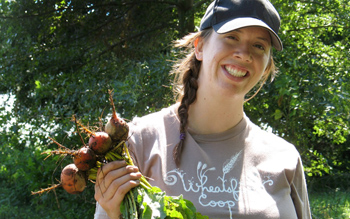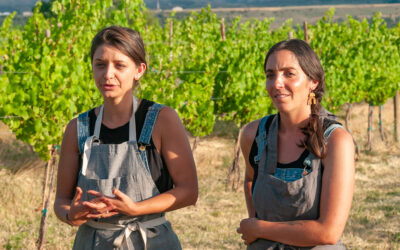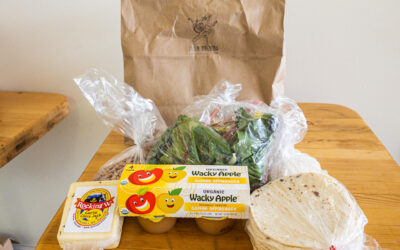By Sena Christian, YES! Magazine

Lindsey Carpenter keeps records at Grassroots Farm. Photo by Annalise Canfield.
When Lindsey Morris Carpenter was a college student studying art in Philadelphia, she never expected that, just a decade later, she would spend most of her days fixing up tractors, turning piles of manure, and corralling chickens.
But that’s precisely what she’s doing. Carpenter, 29, dropped out of school in 2004 and returned to her home state of Wisconsin, where she found a job on a vegetable farm. She went on to apprentice at a larger operation in suburban Chicago and eventually secured employment at an urban farm on the city’s south side, teaching previously incarcerated people how to grow food.
By 2007, Carpenter had decided she wanted her own piece of land to farm, so she and her mother, Gail, bought 40 acres in south central Wisconsin and got down to business—an opportunity she’s grateful for since she’s aware that not everyone has access to the resources that allowed her to purchase this land.
Today, Carpenter’s certified-organic operation, Grassroots Farm, grows fruit, vegetables, hops, and herbs; she also sells pesticide-free cut flowers and eggs from the farm’s chickens. Being as environmentally sustainable as possible is paramount to Grassroots’ operations, Carpenter says. So, too, is a commitment to provide healthy, fresh food to local people regardless of the size of their bank accounts.
“One of my biggest priorities is affordability,” Carpenter said. She doesn’t want to be the Whole Foods of farm-to-table produce. To that end, she designed her community supported agriculture program to be relatively affordable. She charges only $25 a week for a box of produce, which she offers 16 weeks out of the year.
Carpenter’s been in business for five years and has struggled to make a living; she estimates her take-home income at $1.75 an hour. And while it’s been “shockingly easy” to get support from her neighbors, they’re also “sketched out” by her tattoos, short hair, and unmarried status.
Carpenter is one of America’s new and growing class of women farmers. Her focus on sustainability and social justice represent part of the promise women bring to the sector, while the difficulties she faces demonstrate some of the challenges that stand in their way. Many of those challenges are shared by Carpenter’s male counterparts: inclement weather, insects, weeds, erratic markets, soil erosion, droughts, labor shortages, urbanization, and the expense of sustainable methods that don’t rely on toxic chemicals or machines dependent on fossil fuels. But additional burdens often fall on women farmers, such as childrearing or caring for aging parents.
Luckily, women farmers from earlier generations have built institutions designed to help newcomers. And Denise O’Brien, a farmer from southwest Iowa, has done more than her share.
O’Brien and her husband, Larry Harris, decided they would grow organically when they first started farming in 1976. They were inspired by the first Earth Day in 1970, she says, and the many environmental issues making headlines in the mid-1970s. She talks about organic agriculture in classic environmental terms of doing no harm and leaving the earth in better shape than how you found it.
But the decision to go organic left the couple feeling isolated from local farmers, who mostly grew corn, soybeans, and hay on conventional farms. No networks existed to provide support to farmers who wanted to do things differently.
“When we started farming, we couldn’t even say the ‘O-word’ out loud,”O’Brien said, laughing. “But we’re out now.”
By the mid-1980s, O’Brien and Harris had started an informal network called the Progressive Prairie Alliance. Ten years later, she’d helped to build several organizations that helped farmers work more sustainably and cooperatively, but hadn’t yet done anything specifically to help other women farmers. That changed in 1995, when O’Brien, then president of the National Family Farm Coalition, was asked to give a presentation at the United Nations Fourth World Conference on Women in Beijing.
O’Brien went searching for case studies on American women working in agriculture, but couldn’t find many. She had read The Invisible Farmers: Women in Agricultural Production, a book by Carolyn E. Sachs about women in the industry. She also had her own personal experience to go on—she had lived through the farm crisis of the 1980s when an estimated 200,000 to 300,000 farmers faced financial failure as land and commodity values boomed and busted, interest rates skyrocketed, and thousands went bankrupt.
As some farmers sunk into depression, O’Brien says that in many cases their wives were the ones who kept the operations going. She believed the landscape of industrial agriculture would change as more women farmers became decision makers, and suspected their role would only grow.
What the numbers show
She was right. The number of women who were named as the principal operator of an American farm or ranch increased by nearly 30 percent between 2002 and 2007, according to the U.S. Census of Agriculture. Women composed about 14 percent of principal farm operators in 2007, and that percentage has held steady since then, according to the preliminary 2012 census released in February.
However, that jump may have more to do with what was happening in the census than on the farm. The form used in the 2007 census was the first to allow two primary operators to be listed—so wives now had a place to be named alongside their husbands. The full 2012 census will be released later this spring with data on women as a percentage of all operators, not just the principal ones; in 2007 women made up 30 percent of all farmers.
Part of the picture is that both men and women are leaving the profession, but women are leaving less quickly. The total number of farms in the United States declined by about 5 percent to 2.1 million from 2007 to 2012, with nearly all of those losses concentrated among smaller farms of less than 1,000 acres in size.
And women-operated farms are generally smaller and less profitable than others, according to the new census data. Seventy-five percent of American farms grossed less than $50,000 in 2012; for farms with a female principal operator that figure was 91 percent. About 69 percent of U.S. farms were smaller than 180 acres in size; for farms with a female principal operator that figure was 82 percent.
But it’s not just a picture of women farmers barely scraping by. Census data from 2007 showed that women were more likely than men to operate farms with a diversity of crops, and to own a greater percentage of the land they farmed. Women farmers also tended to sell food directly to the consumer rather than to large food-processing corporations—an approach that the United Nations report has found to be important for improving food systems.
Leigh Adcock, executive director of the Women, Food and Agriculture Network, said she believes the U.S. food system will be healthier when more women farm.
Growing institutions
Last November, more than 400 women from 20 states and four countries assembled in Des Moines, Iowa, for the fourth conference hosted by the Women, Food and Agriculture Network, a nonprofit organization that O’Brien founded in 1997.
WFAN’s mission is to “link and empower women to build food systems and communities that are healthy, just, sustainable, and that promote environmental integrity.” The group encompasses all sorts of women: some who caught the farming bug after careers in other sectors, widows who inherited land, and some who work side-by-side with their partner.
“We don’t just want to link women,” Adcock told attendees. “We want to empower you.”

Women, Food and Agriculture Network Founder Denise O’Brien, left, speaks with Leigh Adcock, the group’s executive director, in November 2013.
The network has been expanding its ranks to provide much-needed camaraderie for women working in a male-dominated field and education on how to lead the sustainable farming movement. This year’s conference included sessions on marketing, soil health, cooperatives, research and grants, pricing, pesticide drift, and wildlife and watershed management. Sustainability was a common theme.
The network has grown from 300 members in 2008 to more than 4,000 today, which suggests women in sustainable agriculture aren’t going away anytime soon. But whether more women means an improved food system is a question that must be answered with evidence, O’Brien said. For now, she’s just trying to get women farmers a seat at the table.
“I believe in my heart of hearts that when portions of the population are left out of things then you’re not hearing the whole picture,” she said.
California produce in Iowa’s farm country?
Being involved with the Women, Food and Agriculture Network has given Iowan farmer Ellen Walsh-Rosmann an outlet for her message that farmers need to make their voices heard on legislation related to food and agriculture. She has hosted politicians at her in-laws’ farm and has lobbied in Washington, D.C.
“[Lobbying trips] made me realize this is not an intimidating system,” she said. “These people are just like us and they come from where we live, they know the same people we know … but we as constituents can really inform them and tell them those stories and update them on the current situation. That’s what our job needs to be.”
Walsh-Rosmann moved with her husband to the small city of Harlan during the month of September, a good time for local food. But when shopping at the grocery store for the first time, she discovered only produce grown in California and wrapped in plastic.

Ellen Walsh-Rosmann runs Pin Oak Place, a 10-acre organic farm in Harlan, Iowa. Photo by Valerie Vozza / Oxfam America.
“We live in Iowa,” she thought. “What’s going on here?”
When she and her husband started Pin Oak Place, a 10-acre farmstead, in 2010, they were adamant they would focus on nourishing their community with fresh, healthy, organically grown vegetables and certified-organic eggs. The time she’d spent at Iowa State University studying the social, political, and economic forces that affect agriculture cemented this mission.
But putting her mission into practice has been a challenge.
“I was doing the local farmers market in my town and I was basically giving food away,” she said, meaning they couldn’t make a profit. The farmers have shifted their business operations to focus on wholesale, targeting nearby Omaha, Neb., and its much larger population.
Between raising her son, dealing with her own health problems, and struggling to build a profitable business based in sustainable farming, life has become a balancing act for Walsh-Rosmann. Her network of other women farmers provides invaluable support.




